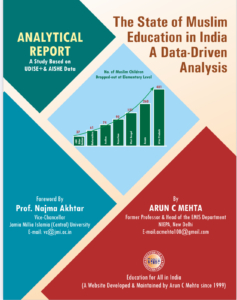Power of Internet Connectivity in Revolutionizing Education in Remote Areas
Abstract
Internet connectivity has emerged as a pivotal force in bridging socio-economic disparities, particularly in remote and underserved regions. This article explores how internet access transforms education, with a focus on school education, and its broader implications for the lives of citizens in remote areas. Drawing on examples from India, such as Arunachal Pradesh, and global case studies, it examines the role of the internet in enhancing teaching, learning, and community engagement. The article also addresses the persistent digital divide, the role of artificial intelligence (AI) in education, and the critical importance of internet availability in remote areas. Finally, it details government initiatives aimed at achieving universal internet access, emphasizing their potential to catalyse socio-economic development.
Introduction
The digital divide – the gap between those with access to information and communication technologies (ICT) and those without – has profound implications for education, economic opportunities, and social inclusion, particularly in remote areas. In regions characterized by challenging terrain, sparse populations, and limited infrastructure, internet connectivity is often a distant dream. However, recent advancements in digital infrastructure, driven by government and private initiatives, are beginning to change this narrative. This article investigates how internet access reshapes education, particularly school education, and transforms the lives of citizens in remote areas. It also explores the broader socio-economic impacts of connectivity, the role of AI in education, and the persistent challenges of the digital divide, with a focus on global and Indian examples, including the transformative efforts in Arunachal Pradesh.
Internet Connectivity and Education in Remote Areas
Internet access is a cornerstone of modern education, enabling access to vast repositories of knowledge, interactive learning platforms, and global communication networks. In remote areas, where traditional educational resources like textbooks and qualified teachers are often scarce, the internet serves as a lifeline for students and educators alike.
Transforming School Education
Internet connectivity revolutionizes school education by providing access to digital resources, online learning platforms, and interactive tools that enhance engagement and learning outcomes. In Arunachal Pradesh, for instance, the BharatNet Phase-II project has brought satellite-powered internet to remote villages like Kibithoo, enabling students to download homework and access educational videos on platforms like YouTube (Boruah, 2025). Similarly, in Menchuka, teachers use smart TVs and internet-based content to make lessons more engaging, compensating for delays in textbook delivery. These examples illustrate how internet access can transform traditional classroom experiences, making learning more dynamic and accessible.
Globally, similar trends are evident. In rural Nigeria, where internet fibre reach is below 50%, initiatives like the Aid for Rural Education Access have introduced digital tools to secondary schools, enabling e-learning despite infrastructural challenges (Outreach International, 2024). In South Korea, government-led programs have made the country a leader in internet usage, with a focus on science and technology education, significantly enhancing learning outcomes (IEEE, 2024). Insights from Education for All in India highlight how digital interventions are reshaping rural education in India, aligning with national policies like the National Education Policy (NEP) 2020.
Enhancing Teaching Practices
The internet empowers teachers by providing access to professional development resources, digital teaching aids, and collaborative platforms. In Arunachal Pradesh’s Lungte village, teachers like Dege Ete use internet-based content to supplement traditional blackboard teaching, showing students documentaries and interactive mathematics apps (Boruah, 2025). This shift not only enhances student engagement but also allows teachers to stay updated with modern pedagogical methods.
Globally, initiatives like the ConnectED program in the United States have provided rural schools with tablets, software, and teacher training, enabling educators to integrate technology into their curricula (American Progress, 2024). In India’s Kalahandi district, the Digital India Program (DIP) has facilitated real-time education through smart and virtual classrooms, addressing teacher shortages in rural areas (Varthana, 2024). Resources on Education for All in India emphasize the importance of teacher training in leveraging digital tools for rural education.
Impact on Parents and Communities
For parents in remote areas, internet connectivity simplifies access to educational resources and administrative processes, directly impacting their children’s schooling. In Arunachal Pradesh, digital centres allow parents to apply for ration cards, birth certificates, and government schemes like PM-Kisan without arduous trips to district headquarters (Boruah, 2025). In Ziro, parents use WhatsApp to market homemade products, generating income to support their children’s schooling.
In rural India, the Education 4.0 initiative emphasizes the importance of digital literacy among families to bridge educational gaps (Varthana, 2024). By equipping parents with digital skills, they can better support their children’s learning, such as accessing online resources or monitoring academic progress. In Nigeria, community-led initiatives supported by NGOs provide digital literacy workshops, empowering parents to engage with e-learning platforms (Outreach International, 2024). Education for All in India underscores the role of community engagement in fostering inclusive education ecosystems.
Broader Impacts of Internet Connectivity
Beyond education, internet connectivity reshapes various aspects of life in remote areas, driving socio-economic development and reducing inequalities.
Economic Opportunities
Internet access enables residents of remote areas to participate in the digital economy. In Arunachal Pradesh, farmers and artisans in Dirang and Ziro use platforms like WhatsApp to market products, expanding their reach to urban markets (Boruah, 2025). In India’s Kalahandi district, the DIP has promoted financial inclusion through digital payments, enhancing economic transparency and formalization (Varthana, 2024). Globally, initiatives like Google’s Next Billion Users program create digital products tailored to underserved communities, fostering economic inclusion (Brookings, 2024). Education for All in India explores how digital access drives economic empowerment in rural areas.
Access to Government Services
Internet connectivity streamlines access to government services, reducing bureaucratic hurdles. In Arunachal Pradesh, digital centres have eliminated the need for long journeys to access schemes like PM-Kisan or pension benefits (Boruah, 2025). In Nigeria, online platforms have facilitated access to government assistance programs, particularly during the COVID-19 pandemic (PMC, 2024). These advancements enhance governance efficiency and ensure that remote communities benefit from public services.
Social Inclusion and Digital Literacy
Internet access fosters social inclusion by connecting remote communities to global networks. However, digital literacy remains a critical challenge. In Arunachal Pradesh, while younger generations adapt quickly, older residents often struggle with digital services due to limited literacy and cybersecurity awareness (Boruah, 2025). In rural Nigeria, NGOs like Outreach International conduct digital literacy workshops to address this gap, empowering communities to leverage technology effectively (Outreach International, 2024). Education for All in India highlights strategies for promoting digital literacy in rural communities.
The Digital Divide and AI in Education
The digital divide remains a significant barrier to equitable education, particularly in remote areas. While AI-driven educational tools – such as personalized learning platforms and adaptive assessments – are transforming education in connected regions, their benefits are inaccessible without reliable internet. For instance, AI can create tailored learning experiences for students, as seen in initiatives leveraging offline educational content in low-connectivity areas (Forbes, 2024). However, the absence of internet infrastructure limits the deployment of such technologies in remote regions.
The digital divide exacerbates educational inequalities, disproportionately affecting marginalized groups. In the United States, 55% of disconnected students come from Black, Hispanic, and Native American households, despite these groups comprising only 40% of the student population (American Progress, 2024). In Nigeria, 89% of students lack access to computers, and 82% lack internet access, severely limiting e-learning opportunities (PMC, 2024). Education for All in India discusses the challenges of bridging the digital divide in India’s education system.
Importance of Internet Availability in Remote Areas
Internet availability in remote areas is critical for several reasons:
- Educational Equity: Internet access ensures that students in remote areas can access the same resources as their urban counterparts, reducing achievement gaps.
- Economic Empowerment: Connectivity enables participation in the digital economy, creating job opportunities and fostering entrepreneurship.
- Social Inclusion: Internet access connects remote communities to global networks, reducing isolation and promoting cultural exchange.
- Governance Efficiency: Digital platforms streamline access to government services, enhancing transparency and accountability.
- Healthcare Access: Internet connectivity facilitates telemedicine, improving health outcomes in areas with limited medical infrastructure.
Government Initiatives for Universal Internet Access
Governments worldwide are prioritizing universal internet access to bridge the digital divide. In India, the BharatNet scheme aims to connect all gram panchayats with high-speed broadband. As of August 2025, over 1,310 gram panchayats in Arunachal Pradesh have been connected, with plans for 1,156 additional 4G towers (Boruah, 2025). The Digital India Program, including initiatives like PM E-vidya and BharatNet, promotes digital inclusion through infrastructure development and digital literacy programs. The Pradhan Mantri Gramin Digital Saksharta Abhiyan (PMGDISHA) targets rural populations, imparting digital skills to enhance technology adoption (Varthana, 2024). Education for All in India provides detailed insights into how NEP 2020 and Digital India align to promote digital education.
Globally, the United Nations’ Broadband Commission and Giga Initiative aim to connect every school to the internet, focusing on underserved regions (Brookings, 2024). In the United States, the Infrastructure Investment and Jobs Act (IIJA) allocates $65 billion for broadband deployment, targeting rural and low-income communities (PGPF, 2024). South Korea’s government programs have transformed the country into a global leader in internet access, emphasizing education and digital skills (IEEE, 2024).
Challenges and Recommendations
Despite progress, challenges like unreliable power, harsh weather, and limited digital literacy persist in remote areas. To address these:
- Infrastructure Investment: Governments should prioritize robust broadband infrastructure, including satellite and microwave links, to ensure reliable connectivity.
- Digital Literacy Programs: Comprehensive training for students, teachers, and parents is essential to maximize the benefits of internet access.
- Public-Private Partnerships: Collaborations with private entities, as seen in the ConnectED initiative, can accelerate infrastructure development and resource provision.
- Affordable Access: Subsidized devices and data plans, as implemented in the U.S. Affordable Connectivity Fund, can enhance accessibility.
- Localized Content: Developing culturally relevant digital content, as practiced by NGOs like Outreach International, ensures community engagement.
Concluding Observations
Internet connectivity is a transformative force for remote communities, revolutionizing education, empowering teachers, and enhancing socio-economic opportunities. Examples from Arunachal Pradesh, Nigeria, and the United States illustrate its potential to bridge educational and economic gaps. However, the digital divide remains a significant challenge, limiting access to AI-driven educational tools and perpetuating inequalities. Government initiatives like BharatNet, Digital India, and global programs like the UN’s Giga Initiative are critical steps toward universal connectivity. By addressing infrastructure, literacy, and affordability challenges, policymakers can ensure that the internet becomes a catalyst for equitable education and inclusive development in remote areas.
Suggested Readings
- American Progress. (2024). How States and Districts Can Close the Digital Divide To Increase College and Career Readiness.
- Boruah, U. (2025). From education to e-commerce, internet connectivity rewiring life in Arunachal Pradesh. education.economictimes.indiatimes.com
- Brookings. (2024). Fixing the global digital divide and digital access gap. www.brookings.edu
- Brookings. (2024). Bridging digital divides between schools and communities. www.brookings.edu
- Economist. (2024). Connecting learners: Narrowing the educational divide. connectinglearners.economist.com
- Forbes. (2024). Addressing The Digital Divide In Education: Technology And Internet Access For Students In Underserved Communities. www.forbes.com
- IEEE. (2024). Digital Divide in Developing Countries: Why We Need to Close the Gap. ctu.ieee.org
- IEEE. (2024). Impact of the Digital Divide: Economic, Social, and Educational Consequences. ctu.ieee.org
- Outreach International. (2024). What is the Digital Divide in Education? outreach-international.org
- PGPF. (2024). Broadband Access and the Digital Divide: What Is the Government’s Role? www.pgpf.org
- PMC. (2024). Left behind? The effects of digital gaps on e-learning in rural secondary schools and remote communities across Nigeria during the COVID19 pandemic. pmc.ncbi.nlm.nih.gov
- Varthana. (2024). Bridging the Digital Divide in Rural Education. varthana.com
- Education for All in India. (2024). Digital Learning in India.


